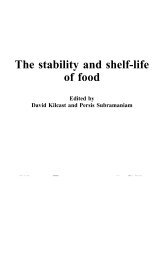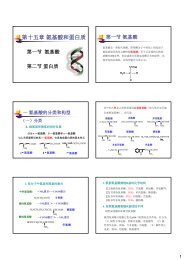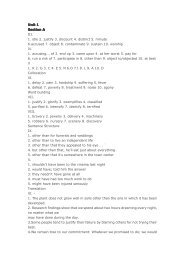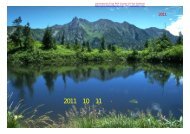Controlled Atmosphere Storage of Fruits and Vegetables, Second ...
Controlled Atmosphere Storage of Fruits and Vegetables, Second ...
Controlled Atmosphere Storage of Fruits and Vegetables, Second ...
Create successful ePaper yourself
Turn your PDF publications into a flip-book with our unique Google optimized e-Paper software.
24 Chapter 2regimes were interrupted by a 3-week period<strong>of</strong> ventilation with air, beginning on 15 January,26 January, 17 February or 11 March, afterwhich the CA treatment was reinstated. Ventilationat the time <strong>of</strong> the climacteric in lateFebruary to early March produced largeincreases in respiration rate <strong>and</strong> volatile flavoursubstances, but ventilation at other timeshad little effect. After CA conditions wererestored, respiration rate <strong>and</strong> the production<strong>of</strong> flavour substances declined again, sometimesto below the level <strong>of</strong> fruit stored in continuouscontrolled atmospheres.<strong>Storage</strong> <strong>of</strong> bananas at high temperatures,as may happen in producing countries, cancause physiological disorders <strong>and</strong> unsatisfactoryripening. In trials with the cultivar Poy<strong>of</strong>rom Cameroon, storage at 30–40 °C wasinterrupted by one to three periods at 20 °Cfor 12 h either in air or in atmospheres containing50% O 2or 5% O 2. Damage wasreduced, especially when fruits were storedat 30 °C <strong>and</strong> received three cooling periods in50% O 2(Dick <strong>and</strong> Marcellin, 1985). Parsonset al. (1974) interrupted CA storage <strong>of</strong> tomatoesat 3% O 2+ 0, 3 or 5% CO 2each week byexposing them to air for 16 h at 13 °C. Thisinterrupted storage had no measurable effecton the storage life <strong>of</strong> the fruit but increasedthe level <strong>of</strong> decay that developed on fruitwhen removed from storage to higher temperaturesto simulate shelf-life. Intermittentexposure <strong>of</strong> Haas avocados to 20% CO 2increased their storage life at 12 °C <strong>and</strong>reduced chilling injury during storage at 4 °Ccompared with those stored in air at the sametemperatures (Marcellin <strong>and</strong> Chaves, 1983).Anderson (1982) described experiments wherepeaches <strong>and</strong> nectarines were stored at 0 °C in5% CO 2+ 1% O 2, which was interrupted every2 days by removing the fruits to 18–20 °C inair. When subsequently ripened, fruits in thistreatment had little <strong>of</strong> the internal breakdownfound in fruits stored in air at 0 °C.Residual Effects <strong>of</strong> CA <strong>Storage</strong>There is considerable evidence in the literaturethat storing fruits <strong>and</strong> vegetables in CAstorage can affect their subsequent shelf- ormarketable life. Day (1996) indicated thatminimally processed fruits <strong>and</strong> vegetablesstored in 70% <strong>and</strong> higher O 2levels deterioratedmore slowly on removal than thosefreshly prepared. Hill (1913) described experimentson peaches stored in increased levels<strong>of</strong> CO 2<strong>and</strong> showed that their respiration ratewas reduced, not only during exposure;he also showed that respiration rate onlyreturned to the normal level after a few daysin air. Bell peppers exposed to 1.5% O 2for1 day exhibited a suppressed respiration ratefor at least 24 h after transfer to air (Rahmanet al., 1993a). Berard (1985) showed that cabbagestored at 1 °C <strong>and</strong> 92% rh in 2.5% O 2+5% CO 2had reduced losses during long-termstorage compared with that stored in air, butalso the beneficial effects persisted afterremoval from CA. Burdon et al. (2008) showedthat avocados that had been stored in CA hada longer shelf-life than those that had beenstored in air for a similar period.Goulart et al. (1990) showed that whenBristol raspberries were stored at 5 °C in 2.6,5.4 or 8.3% O 2+ 10.5, 15.0 or 19.6% CO 2or inair the weight loss was greatest after 3 daysfor fruit stored in air. When fruits wereremoved from CA after 3 days <strong>and</strong> held for 4days in air at 1 °C, those which had beenstored in 15% CO 2had less deterioration thanany other treatment except for those stored inair. Deterioration was greatest in the fruitswhich had previously been stored in the 2.6,5.4 or 8.3% O 2+ 10.5% CO 2treatments. <strong>Fruits</strong>removed after 7 days <strong>and</strong> held for up to12 days at 1 °C showed least deteriorationafter the 15.0% CO 2storage.The climacteric rise in respiration rate <strong>of</strong>Cherimoya fruit was delayed by storage in 15or 10% O 2, <strong>and</strong> fruits kept in 5% O 2did notshow a detectable climacteric rise <strong>and</strong> did notproduce ethylene. All fruits ripened normallyafter being transferred to air storage at 20 °C;however, the time needed to reach an ediblecondition differed with O 2level <strong>and</strong> wasinversely proportional to O 2concentrationduring storage. The actual data showed thatfollowing 30 days <strong>of</strong> storage in 5, 10 <strong>and</strong> 20%O 2fruits took 11, 6 <strong>and</strong> 3 days respectively toripen at 20 °C (Palma et al., 1993).Fruit firmness can be measured by insertinga metal probe into a fruit <strong>and</strong> measuring



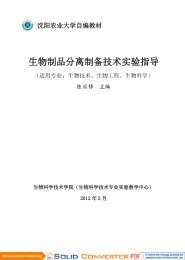

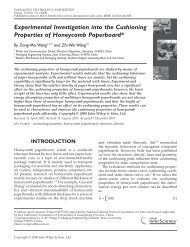
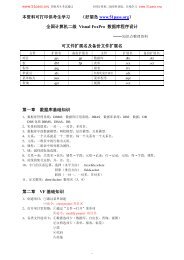
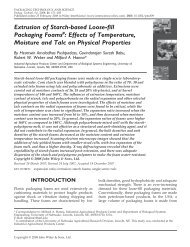
![()] 1](https://img.yumpu.com/45117883/1/190x143/-1.jpg?quality=85)
